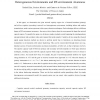Free Online Productivity Tools
i2Speak
i2Symbol
i2OCR
iTex2Img
iWeb2Print
iWeb2Shot
i2Type
iPdf2Split
iPdf2Merge
i2Bopomofo
i2Arabic
i2Style
i2Image
i2PDF
iLatex2Rtf
Sci2ools
JSAC
2011
2011
Joint Network Capacity Region for Cognitive Networks Heterogeneous Environments and RF-Environment Awareness
In this paper, we characterize the joint network capacity region for a licensed broadcast (primary) and ad hoc cognitive (secondary) network in a heterogeneous environment, including indoor and outdoor transmissions, under various spectrum (white space) detection techniques. Each technique delivers a different degree of RF-environment awareness - the more a device knows about its environment the larger the network capacity region. To quantify the gains, we develop a simple stochastic model capturing the interdependency amongst primary and secondary nodes and compare their joint capacity. Cognitive devices using the classical signal energy detection method are shown to perform poorly due to limitations on detecting primary transmitters in environments with indoor shadowing. This can be circumvented through direct use (e.g., database access) of location information on primary transmitters, or better yet, on that of primary receivers. The specific capacity trade-off between primary and ...
| Added | 14 May 2011 |
| Updated | 14 May 2011 |
| Type | Journal |
| Year | 2011 |
| Where | JSAC |
| Authors | Yuchul Kim, Gustavo de Veciana |
Comments (0)

